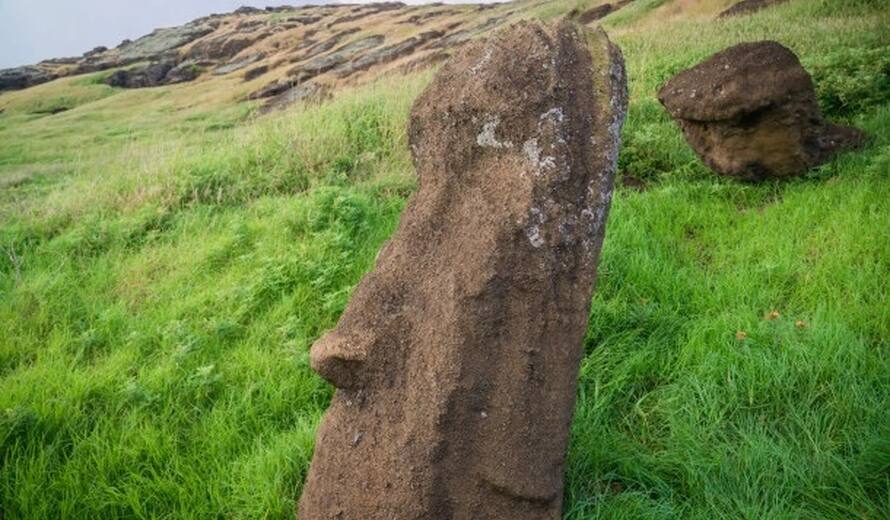UNESCO diagnosis identifies conservation state of Rapa Nui heritage resources and proposes suggestions for their preservation
Among the damage found, much of it as a result of the fires that occurred in October 2022, there are serious alterations in 22 moai, caused by various factors, which must be addressed in the short term.
After this first phase of diagnosis following the fires, a participatory risk management plan will be developed. Simultaneously, training will be conducted on topics such as mitigation, emergency prevention, and care of heritage sites.
In response to the devastating fires of 2022 at Rapa Nui Park, UNESCO completed in June 2023 a detailed diagnosis of the damage to archaeological resources and stressed the need for short-term interventions to protect and preserve this world-renowned heritage site.
The fires, which took place on October 4, 2022, primarily affected the Rano Raraku visitation site, known for being the quarry of the moai, the iconic statues of Rapa Nui (also known as Easter Island). As a result of the fire, numerous archaeological resources were subjected to high temperatures, compromising their preservation. Likewise, other damage factors of various origins were found. Due to all these causes, there are serious alterations in 22 moai, which need to be addressed in the short term.
To address this crisis, UNESCO, in collaboration with the indigenous community Mau Henua, government entities, and civil society, initiated response actions to assess the damage and develop a risk management plan for the Rano Raraku site, which is part of the World Heritage site. The plan not only seeks to diagnose the conservation status of the site after the fires but also to strengthen local capacities to prevent future disasters and respond in a coordinated and timely manner to any calamity, aiming to protect the valuable cultural and archaeological goods of the site.
The diagnosis, developed by a multidisciplinary team, was based on previous records made at Rano Raraku and established a methodology that allowed the evaluation of the 358 archaeological elements of the site on a numerical scale according to the extent and intensity of the alteration of the affected resources. According to specialists, alteration agents include not only fires but also climatic, water, biological, and direct anthropic factors.
Different symptoms of alteration were identified in the archaeological resources, such as changes in coloration, erosion, presence of vegetation, lichens, and flaking. The diagnosis highlights that erosion caused by climatic and water factors is the most recurrent and damaging alteration since it affects the shape and stylistic features of the moai.
Experts also emphasize the need to intervene in those archaeological resources with high levels of alteration in the short term. It is proposed to apply bio-deterioration control techniques, consolidation, and hydrophobic treatment, as well as implement measures to prevent and mitigate forest fires in the area.
The UNESCO representative in Chile, Claudia Uribe, underscored the importance of a coordinated action to protect the valuable heritage of the island. "The conservation and proper management of this cultural legacy are fundamental for the Rapa Nui people and for humanity given its immense heritage value," she said. She also pointed out that "UNESCO will continue supporting recovery efforts in Rapa Nui, promoting awareness of the importance of protecting heritage and strengthening local capacities in the management and conservation of the World Heritage site."
UNESCO's Heritage Emergency Fund (HEF)
This UNESCO fund finances activities for preparation and response to emergency situations in the fields of global conventions related to culture. This includes immovable cultural and natural heritage, movable cultural heritage, cultural repositories, underwater cultural heritage, intangible cultural heritage, and the diversity of cultural goods, services, and expressions.
Among the objectives of the Fund is to strengthen the capacity of Member States to prevent, mitigate, and recover the loss of heritage and cultural diversity as a consequence of conflicts and natural disasters, as happened in Rapa Nui.
UNESCO thanks the donors who make this initiative possible: the Qatar Fund for Development, the Government of Canada, the Kingdom of Norway, the Republic of France, the Principality of Monaco, ANA Holdings INC., the Republic of Estonia, the Kingdom of the Netherlands, the Slovak Republic, the Grand Duchy of Luxembourg, the Principality of Andorra, and the Republic of Serbia.
